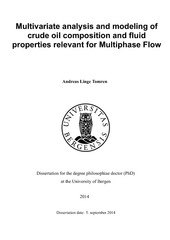| dc.contributor.author | Tomren, Andreas Linge | eng |
| dc.date.accessioned | 2014-12-03T10:28:42Z | |
| dc.date.available | 2014-12-03T10:28:42Z | |
| dc.date.issued | 2014-09-05 | eng |
| dc.identifier.isbn | 978-82-308-2843-4 | |
| dc.identifier.uri | https://hdl.handle.net/1956/8813 | |
| dc.description.abstract | Crude oil composition and properties have been subject for research for several decades, as well as the correlation between the chemical composition and physical properties of crude oil. The physical properties of crude oil are strongly dependent upon the chemical composition of the oil, and both physical properties and composition provide important information for the oil producers as different challenges might occur when handling certain types of crude oil; corrosion, deposition of solids and plugging of pipelines are just some examples. As a mean of detecting possible threats and monitoring the flow through the pipelines, a number of metering devices can be applied, for example a Multiphase Flow Meter, which can provide measurements of the water cut and the flow rates of oil, gas and water in pipelines, as well as pressure and density. The aim of this work is to improve the general understanding of how the distribution of the different compounds in crude oil influence the physical properties of crude oil, in particular the properties that are involved in Multiphase Flow Metering, where permittivity is of special relevance. By improving this understanding, the project seeks to improve the knowledge base on the interactions between the chemistry of the petroleum fluids and the parameters that provide the basis for the performance of the Multiphase Flow Metering systems. In this work, calibration models of several physical properties and compositional data has been built, based on GC and IR data respectively. Several of the models are obtained with good predictive quality, for instance the models for static and high frequency permittivity, density and velocity of sound. Also, a clear biodegradation effect has been identified in the regression coefficients for these properties, indicating that biodegradation has a significant effect on their variation. A multivariate calculation tool for estimation of static permittivity of crude oils based on PVT data has been developed during the thesis work, and this tool has been vi applied by Roxar ASA. The tool gives a better initial calibration of the Multiphase Flow Metering systems, as the static permittivity is more accurately determined compared to the previously used methods. The tool should also be able to identify significant changes in oil composition and properties for example during the production lifetime of an oil field (given representative PVT data), and recalibrate values in Multiphase Flow Metering systems accordingly. | en_US |
| dc.language.iso | eng | eng |
| dc.publisher | The University of Bergen | en_US |
| dc.relation.haspart | Research report: Tomren, A.L.; Barth, T.; Folgerø, K. Introductory chemometric analysis of crude oil composition and fluid properties. Full text not available in BORA. | en_US |
| dc.relation.haspart | Paper I: Tomren, A.L.; Barth, T.; Folgerø, K. 2012. Multivariate analysis of crude oil composition and fluid properties used in Multiphase Flow Metering. Energy Fuels, 56, 5679-5688. Full text not available in BORA due to publisher restrictions. The article is available at: <a href="http://dx.doi.org/10.1021/ef300620r" target="blank">http://dx.doi.org/10.1021/ef300620r</a>. | en_US |
| dc.relation.haspart | Paper II: Tomren, A.L.; Barth, T. 2014. Comparison of Partial Least Squares calibration models of viscosity, acid number and asphaltene content in petroleum, based on GC and IR data. Fuel, 120, 8-21. Full text not available in BORA due to publisher restrictions. The article is available at: <a href="http://dx.doi.org/10.1016/j.fuel.2013.11.065" target="blank">http://dx.doi.org/10.1016/j.fuel.2013.11.065</a>. | en_US |
| dc.relation.haspart | Paper III: Carlson, J.E.; Tomren, A.L.; Folgerø, K.; Barth, T. 2014. Estimation of dielectric properties of crude oils based on IR spectroscopy. Chemometrics and Intelligent Laboratory Systems, 139, 1-5. Full text not available in BORA due to publisher restrictions. The article is available at: <a href="http://dx.doi.org/10.1016/j.chemolab.2014.09.001" target="blank">http://dx.doi.org/10.1016/j.chemolab.2014.09.001</a>. | en_US |
| dc.relation.haspart | Paper IV: Folgerø, K.; Tomren, A. L.; Frøyen, S. 2012. Permittivity calculator. Method and tool for calculating the permittivity of oils from PVT data. Conjerence proceedings, 30th International North Sea Flow Measurement Workshop, St. Andrews, 23rd - 26th October. Full text not available in BORA. | en_US |
| dc.title | Multivariate analysis and modeling of crude oil composition and fluid properties relevant for Multiphase Flow Metering | en_US |
| dc.type | Doctoral thesis | |
| dc.rights.holder | Copyright the author. All rights reserved | en_US |
| dc.identifier.cristin | 1152708 | |
